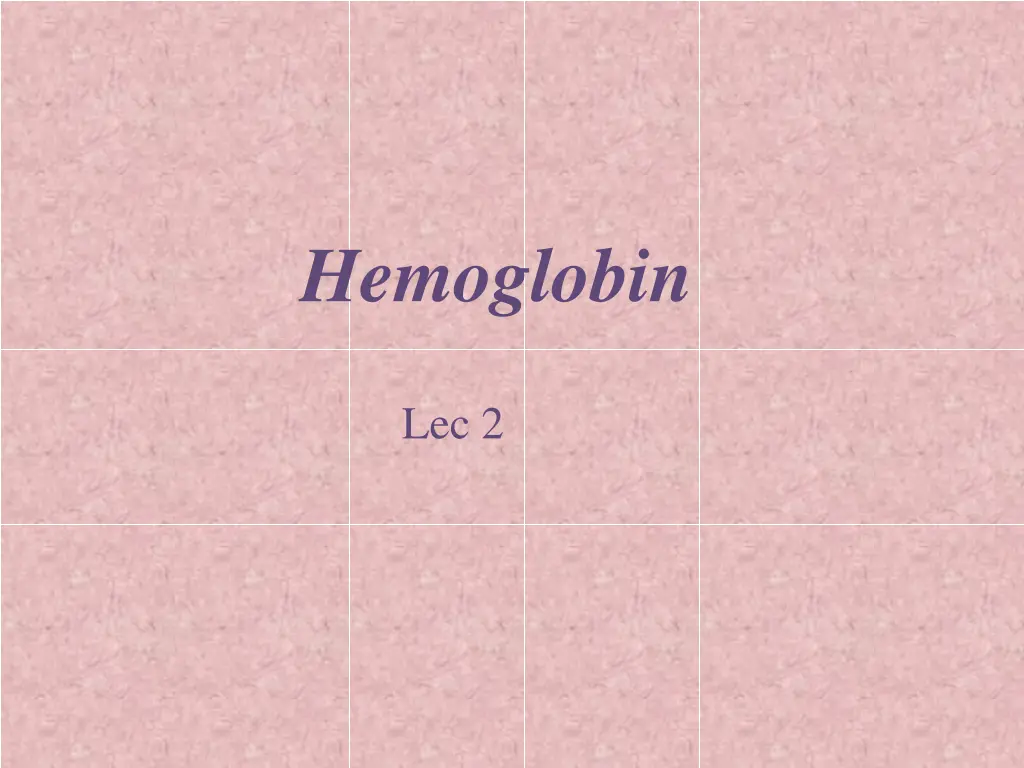
Understanding Hemoglobin Structure and Function
Explore the structure and function of hemoglobin, the protein in red blood cells responsible for carrying oxygen. Learn about normal hemoglobin, abnormal types like in sickle cell anemia and thalassemia, and the synthesis process. Discover how hemoglobin's iron-containing heme groups bind oxygen and how abnormalities can impact oxygen transport in the body.
Download Presentation

Please find below an Image/Link to download the presentation.
The content on the website is provided AS IS for your information and personal use only. It may not be sold, licensed, or shared on other websites without obtaining consent from the author. If you encounter any issues during the download, it is possible that the publisher has removed the file from their server.
You are allowed to download the files provided on this website for personal or commercial use, subject to the condition that they are used lawfully. All files are the property of their respective owners.
The content on the website is provided AS IS for your information and personal use only. It may not be sold, licensed, or shared on other websites without obtaining consent from the author.
E N D
Presentation Transcript
Hemoglobin Lec 2
Hemoglobin Erythrocyte contains about 280 million hemoglobin molecules which give blood its red color. Hemoglobin forms 80% of the dry weight of RBC Structure of hemoglobin. Each hemoglobin molecule consists of 4 protein chains called globin, each one is bound to one heme. Heme is an iron-containing porphyrin derivative. The iron group of heme able to combine with oxygen in the lung and release oxygen in the tissues. Iron in the hemoglobin is in form of ferrous state Fe++ The most form of Hb in adult human being is hemoglobin A. There is four polypeptides form the globin portion of hemoglobin molecule. It is a combination of two alpha chains and two beta chains. The alpha polypeptide consist of 141 A. A while the polypeptide consist of 146 A.A. each chain combined with heme. This type of hemoglobin called adult hemoglobin or (HbA).
Because each chain has a heme so there are 4 iron atoms in each hemoglobin molecule each of these can bind with 1 Molecule of O2(or 8 oxygen atoms). Making a total of 4 molecules of O2(or 8 oxygen atoms) The nature of hemoglobin chain determines the binding affinity of Hb for oxygen. Abnormality of chain can alter the physical characteristics of Hb.
In sickle cell anemia, the amino acid valine is substituted for glutamic acid in the 6th position of the two beta chains. This type of hemoglobin is called hemoglobin S. When this type of Hb is exposed to low oxygen it forms elongated crystal inside RBC. That are sometimes 15 m in length. This make it almost impossible for the cells to pass through small capillaries, and the spiked ends of crystals are likely to rupture the cell membrane leading to hemolysis and sickle cell anemia. Note: Hb F (fetal Hb) present in the blood of Fetus, these Hb will be changed rapidly after birth into Hb A and completed on 6- 12 months. Hb F composed from two and two chain .
Thalassemia: In thalassemia, the polypeptide chains are normal but produced in decreased amounts or absent due to decreased synthesis. This is because of the defects in the regulatory portion of globin genes. In -thalassemia the amount of -chain is decreased or absent, whereas in -thalassemia, - chain is decreased or absent. -thalassemia is of two types, thalassemia major (Mediterranean anemia or Cooley's anemia) and thalassemia minor (more common).
Synthesis of hemoglobin Hemoglobin synthesis is occur in the cytoplasm of the proerythroblast during erythropoiesis. Heme is synthesized in the mitochondria from succinyl CoA and glycine I. 2 succinyl-CoA+ 2glycine pyrole II. 4 pyrole IX + Fe hems Globin part of hemoglobin is synthesized in the ribosome from amino acids III. Heme + polypeptide hemoglobin chain ( or ) IV. 2 Chain + 2 chain hemoglobinA
IRON METABOLISM when iron absorbed from small intestine it combine in blood plasma with beta apotransferrin) to form transported in the plasma. The iron is loosely combined with globin molecule and be released to any tissue cells, excess iron in the blood is deposited in all cells of the body but especially in liver and less in the reticuloendothelial cell of bone marrow. In the cell cytoplasm, it combine mainly with a protein apoferritin to form ferritin. This iron stored as ferritin is called storage iron. Smaller quantities of the iron in storage pool are stored in an insoluble form called hemosidrine. globin (also which called then transferrin
When the quantity of iron in plasma decrease iron removed from ferritin. transported in the form transferrin in the plasma to the proteins of the body where it is needed. The iron is then When RBCs are destroyed, the hemoglobin released from the cell is ingested by the cell of monocyte macrophage reticuloendothelial system) especially spleen and free iron is liberated and stored in the ferritin pool or re-used for formation of hemoglobin. system (also called
Types of hemoglobin according to the chemical attached: 1) Oxyhemoglobin HbO2 When attached with O2and it is mostly present in arterial blood. 2) Deoxy Hb After hemoglobin give the O2, the hemoglobin called deoxy hemoglobin. 3) Dicarboxy Hb (Hb CO2) 4) Carboxy Hb (Hb CO) When Hb combined with CO, the affinity of Hb to combine with Co more than the combination with O2. 5) Met Hb This type occur when expose to drug or food have oxidizing agent such as aspirin, this material convert ferrous F++to ferric F+++. 6) Glycosylated Hb (HbAIc): in this glucose attached to the terminal valine in the beta chain of HbA.
Destruction of RBC Once the cell membrane become fragile, the cell rupture in the circulation, many of RBC break down in spleen where they squeeze through the red pulp through which most of the cell must pass are only 3 m wide while RBC diameter 7.8 m.
